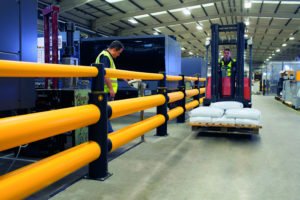Darren Clapich, Business Development Manager at HGVC, talks to SHD Logistics about the safety of our most important asset – our people – and how it continues to change.
 Safety is paramount in logistics. Processes which prevent forklift truck operators seriously injuring pedestrian colleagues or which prevent dangerous HGV driving – among other things – are part of the business model, emphasised with good training.
Safety is paramount in logistics. Processes which prevent forklift truck operators seriously injuring pedestrian colleagues or which prevent dangerous HGV driving – among other things – are part of the business model, emphasised with good training.
But accidents still take place. Figures based on RIDDOR over the last three years show that 43% of incidents involving a fork lift truck were impacts with a third person; 15% were delivery drivers watching or assisting with loading/unloading their vehicle.
Safety features are now built into transport technology, from sensors on counterbalance trucks to telematics on HGVs.
Wincanton reduced harsh braking incidents by 83%, saw an 89% reduction in over-speeding events and a 28% reduction in total RTAs (Road Traffic Accidents), following the introduction of a new telematics system, reported by SHD Logistics last year.
Technology plays a part in keeping operators safe, but it can’t replace competent training, which is the foundation of driver safety. At HGVC we’ve trained over 10,000 drivers and coordinated hundreds of companies’ training programmes, large and small across the length and breadth of the UK. We see first-hand how quality training helps save lives and retain staff.
It’s not just physical safety that needs to be considered: mental health is also crucial, now more than ever.
In 2017 The Office for National Statistics reported that drivers of work lift trucks had a suicide rate 85% higher than the national average. Van drivers were noted to have a rate 25% higher, and drivers of large goods vehicles 20% higher than the national average.
COVID-19
 Safety in transport and logistics has taken on a new meaning since the arrival of COVID-19.
Safety in transport and logistics has taken on a new meaning since the arrival of COVID-19.
‘Wash hands’ has earned its place next to ‘wear seatbelt’ and ‘stay on the pedestrian path.’
Increasing the frequency of hand washing and surface cleaning, using screens or barriers to separate people from each other and using back-to-back or side-to-side working (rather than face-to-face) – which is government advice – has been achievable for many operators, as is providing dedicated waiting areas with welfare and rest room facilities for drivers when delivering and collecting goods (although the HSE did report it received complaints that drivers were not being allowed to use welfare facilities when they deliver, which is against the law).
There have been great examples of proactive operators across the logistics media, from deep cleans at Hermes hubs to the introduction of copper films to door handles (a surface which the virus only lives on for minutes) at the Combilift plant in Monaghan, Ireland.
Safety next steps
So what next? Remote working and the digital workplace will play a key role in keeping our staff safe and the use of automated and digital systems will continue to change the way we work as individuals and within facilities/on the roads.
Thanks to our devoted team, HGVC is now delivering CPC courses online, and will continue to do so as a safer option for our future workforce.
The user experience of our online portal has never been more important. For large-scale CPC programmes, transport managers have access to a custom online portal so drivers can be added and progress can be monitored.
Our portal allows us to keep a full track of a driver’s Driver Qualification Card (DQC), can remind users when the courses need to be taken, and even provide automated course-booking so DQCs don’t lapse.
The dashboard gives live information on progress and KPIs, and can be customised to suit each client.
Jobs and training will undoubtedly include virtual and physical workspaces in future, and as a supplier to the profession, we’re eager to play our part and make it easier for our clients and their drivers to do their job/training safely with the systems we create.
We’re not alone. Universities in the UK are being encouraged to halt plans for face-to-face teaching. Facebook is allowing employees to work from home until July 2021 and will give them a budget for home office needs.
McKinsey & Company has made some safety suggestions for logistics operators. Hot spot surfaces marked with colour, contactless authentication methods like facial recognition, improved air filtration and ventilation systems, worker proximity sensors, the removal of high-touch objects and automatic sanitisation of surfaces after each use.
The reality is, the future workplace will be blended, with both virtual and physical working environments, testing safety every step of the way. But regardless of which realm you’re in, I have little doubt it will be digital.
Accidents will still take place, pandemics will loom (we’ll all be ready next time) but there is plenty we can do on every level to keep staff safe.
This article was originally published on SHD Logistics.
Logistics news app
 SHD Logistics, provider of news, case studies and opinions from the logistics sector, has launched a new app. It will be available on the Apple App Store and on your desktop. Once downloaded, the app will allow you to save, read, search and share digital editions of SHD Logistics.
SHD Logistics, provider of news, case studies and opinions from the logistics sector, has launched a new app. It will be available on the Apple App Store and on your desktop. Once downloaded, the app will allow you to save, read, search and share digital editions of SHD Logistics.
SHD covers many verticals including retail and fashion, food and beverage, engineering, manufacturing, and transport and distribution. SHD is a must-read publication for today’s busy logistics and supply chain professionals.
Advance your career in health and safety
Browse hundreds of jobs in health and safety, brought to you by SHP4Jobs, and take your next steps as a consultant, health and safety officer, environmental advisor, health and wellbeing manager and more.
Or, if you’re a recruiter, post jobs and use our database to discover the most qualified candidates.

 Safety is paramount in
Safety is paramount in  Safety in transport and logistics has taken on a new meaning since the arrival of
Safety in transport and logistics has taken on a new meaning since the arrival of  SHD Logistics, provider of news, case studies and opinions from the logistics sector, has
SHD Logistics, provider of news, case studies and opinions from the logistics sector, has